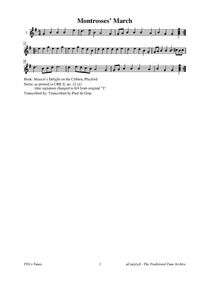Template:Pagina principale/Vetrina: Difference between revisions
No edit summary |
No edit summary |
||
| Line 1: | Line 1: | ||
{{SheetMusic | {{SheetMusic | ||
|f_track= | |f_track=Montrose's March.mp3 | ||
|f_pdf= | |f_pdf=Montrose's March.pdf | ||
|f_artwork= | |f_artwork=Graham.jpg | ||
|f_tune_name= | |f_tune_name=Montrose's March | ||
|f_track_title= | |f_track_title=Montrose's_March | ||
|f_section=abc | |f_section=abc | ||
|f_played_by=[https:// | |f_played_by=[https://www.youtube.com/watch?v=3H6dk2YghDg Ben Miller & Anita MacDonald] | ||
|f_notes= | |f_notes= James Graham, 1st Marquess of Montrose. | ||
|f_caption=The | |f_caption=The title refers to the heroic Marquess of Montrose (1612–1650), James Graham, a 17th century Scottish aristocrat chosen by Charles I of England to quell a rebellion in Scotland, and reputedly a man who lived scrupulously and bravely. | ||
|f_source=[https://www.youtube.com/watch?v=3H6dk2YghDg Youtube] | |||
|f_source=[https:// | |||
|f_pix=420 | |f_pix=420 | ||
|f_picpix=200 | |f_picpix=200 | ||
|f_article=[[ | |f_article=[[Montrose's_March | '''Montrose's March''']] | ||
The title | The title was published by Playford in his '''Musick's Recreation''' (1669), however, the melody earlier appeared in Playford's '''Musick's Hand-Maid''' (1663) as the generically-title "A Scotish [sic] March." William Stenhouse, in his '''Illustrations''' to the '''Scots Musical Museum''' (p. 197), opined "the second strain contains a redundant bar which spoils the measure". It is the ancestral melody for a widespread and varied tune family found throughout Britain and Ireland, and was also imported to North America<ref>See Prof. Samuel Bayard's remarks on the tune family in '''Dance to the Fiddle, March to the Fife''', 1981.</ref>. One of its more famous derivatives is "[[Rock and a Wee Pickle Tow (A)]]," which appeared in Joseph Mitchell's opera '''Highland Fair; or, A Union of the Clans''' (1731), later printed in London publisher James Oswald's '''Curious Collection of Scots Tunes''' (1739). See also the distanced derivative "[[Old Woman Tossed Up in a Blanket (4)]]." | ||
}} | }} | ||
Revision as of 12:43, 13 April 2023

Played by: Ben Miller & Anita MacDonald
Source: Youtube
Image: James Graham, 1st Marquess of Montrose.

The title was published by Playford in his Musick's Recreation (1669), however, the melody earlier appeared in Playford's Musick's Hand-Maid (1663) as the generically-title "A Scotish [sic] March." William Stenhouse, in his Illustrations to the Scots Musical Museum (p. 197), opined "the second strain contains a redundant bar which spoils the measure". It is the ancestral melody for a widespread and varied tune family found throughout Britain and Ireland, and was also imported to North America[1]. One of its more famous derivatives is "Rock and a Wee Pickle Tow (A)," which appeared in Joseph Mitchell's opera Highland Fair; or, A Union of the Clans (1731), later printed in London publisher James Oswald's Curious Collection of Scots Tunes (1739). See also the distanced derivative "Old Woman Tossed Up in a Blanket (4)."
...more at: Montrose's March - full Score(s) and Annotations
X:1 T:Montrosses' March B:Musick's Delight on the Cithren, Playford N:as printed in CRE II, no. 12 (ii) N:time signature changed to 6/4 from original "3" Z:Transcribed by Paul de Grae M:6/4 L:1/4 K:G GBB B2 e|d>eB A2 G|G/A/BB B2 A|BGG [GBdg]:| |:eeg eeg|eeg edB|dde dde|d2 e dBG|G/A/BB B>^cB/c/| d>Bc/d/ e3|de/d/c/B/ A2 G|G/A/BB B2 A|BGG [GBdg]:|
- ↑ See Prof. Samuel Bayard's remarks on the tune family in Dance to the Fiddle, March to the Fife, 1981.
